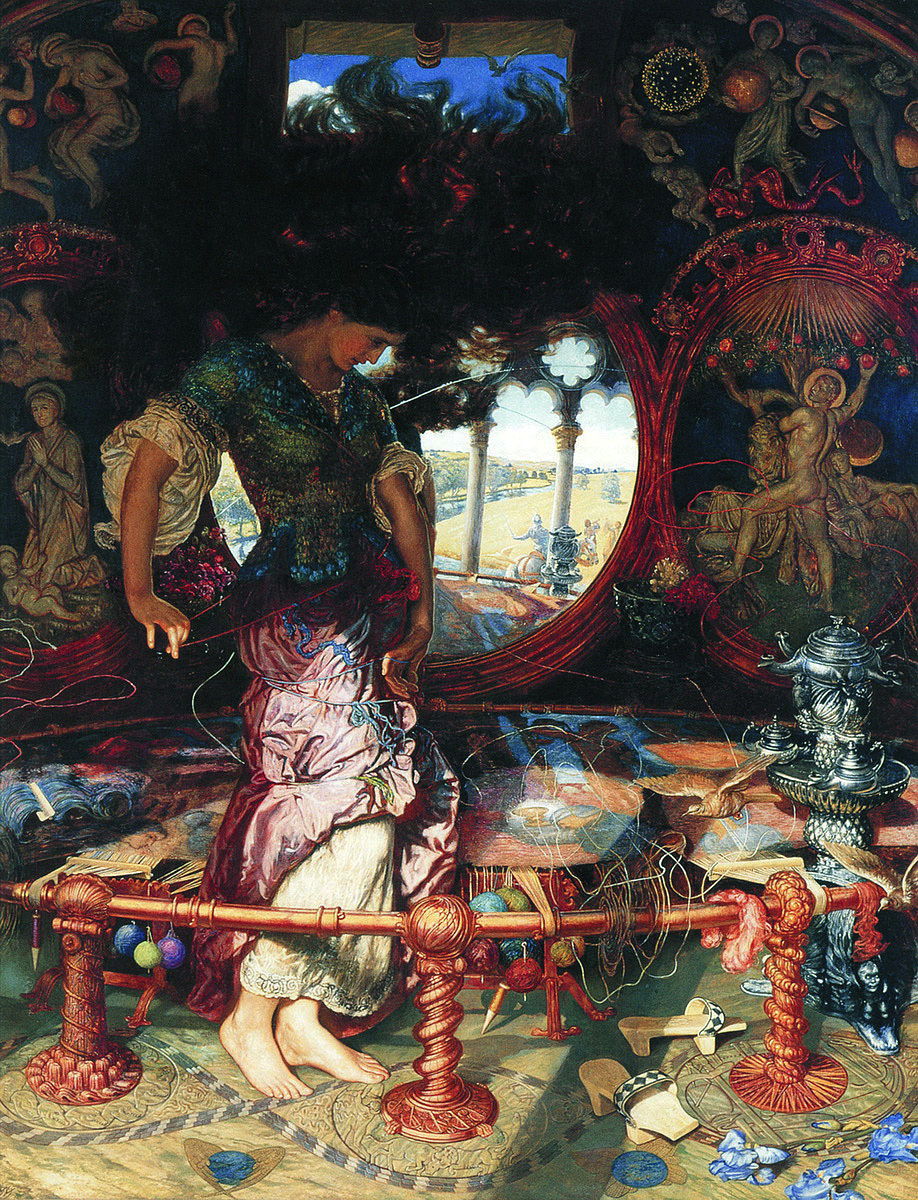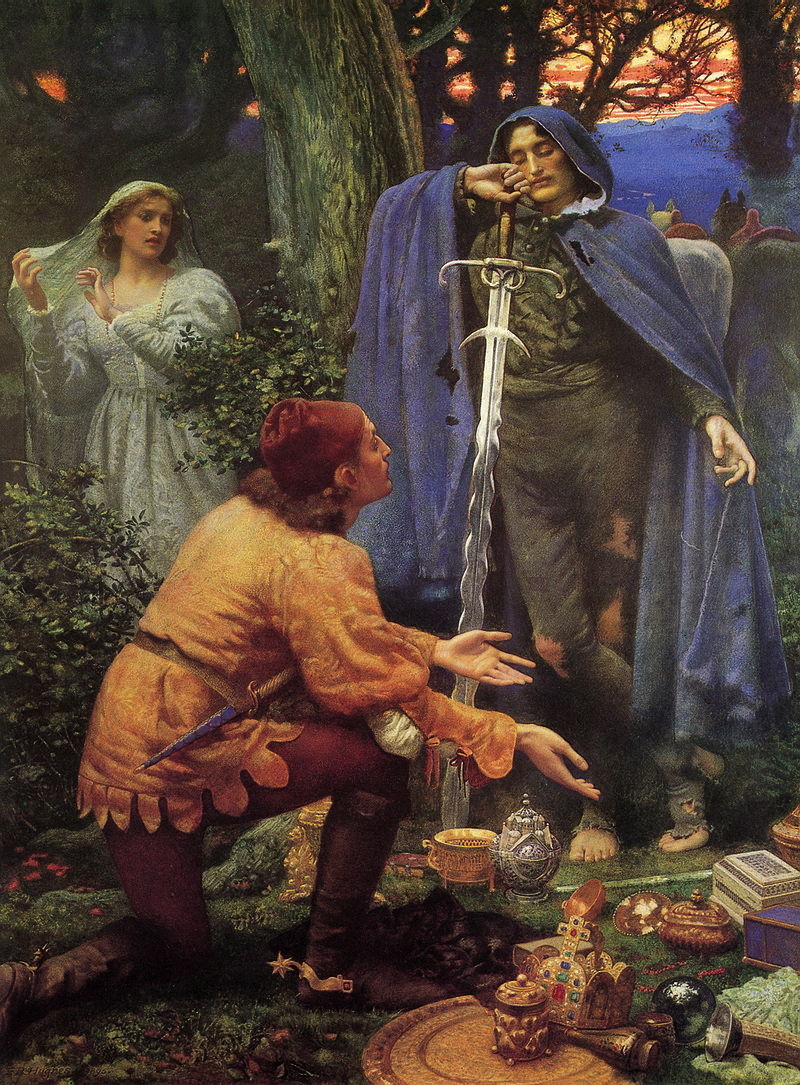Edward Robert Hughes (1851-1914) was trained at the Royal Academy Schools in London from 1868, and became a popular portraitist. In addition, he was a studio assistant for more than fifteen years to the more senior Pre-Raphaelite William Holman Hunt (1827–1910), and a meticulous painter in watercolours.

The two major paintings which Hughes is known to have worked on with Holman Hunt are his late and life-sized version of The Light of the World, which I will not discuss here, and The Lady of Shalott (1905), shown above. The latter was a popular narrative among the Pre-Raphaelites and their followers, and this version is particularly rich in symbols. It also has cross-references to other narratives such as that of Arachne and her spider’s webs, and a full reading would take an article in itself.

Bertuccio’s Bride (1895) is one of Hughes’ earlier narrative paintings, which was derived from a series of illustrations which he painted for WG Waters’ translation of a sixteenth century collection of Italian short stories by the obscure Straparola, known as The Nights of Straparola. These stories are told in a similar manner to those of Bocaccio’s Decameron, although the Nights of Straparola has never achieved the same fame. Many are bawdy tales, and each concludes with a rude riddle.
The story of Bertuccio is fairly straightforward. He uses his inheritance to ransom the body of a man from his murderers, and to free a maiden from robbers. The maiden turns out to be a princess, who makes a contract of betrothal with him before she returns to her kingdom. Bertuccio then meets a mysterious knight, with whom he changes clothes, and goes in quest of his bride. When he is returning home with her, they meet the knight again, and Bertuccio offers to divide with the knight the wedding gifts, in return for the help which the knight provided. However, the knight turns out to be the spirit of the murdered man, whose body he ransomed, and declines the gifts.
Shown here is Bertuccio making the knight the offer to divide the wedding gifts. The princess, in full bridal gown, is seen at the far left, looking anxious. The two men are discussing the matter of the gifts, which are arranged on the ground between them, together with a huge and ornate sword.
Hughes has produced a very detailed painting, in which the two main protagonists lack facial expressions or body language to contribute to the narrative depicted. Other than its involvement of the supernatural, the original story has its peripeteia at the time that the mysterious knight reveals himself to be the spirit of the murdered man, which occurs at some time after the moment shown. Thus a good knowledge of the original narrative is needed in order to read the painting properly.

Diana’s Maidens (1898) shows what I presume is Diana running and clutching her clothes to her naked body, while two other nude women cavort in a distant lake.
Diana was unusual for being primarily a Roman goddess, although she became associated with the Greek goddess Artemis. Sworn never to marry, she was frequently associated with the water nymph Egeria, who was her servant, and Virbius, a woodland god. She is usually portrayed hunting in association with oak woodland, and is often accompanied by deer or hunting dogs. Her most famous associated myth – which is a popular subject for narrative paintings – is that of Actaeon, who saw her bathing naked. Diana metamorphosed him into a deer, and he was promptly attacked and killed by his own hunting dogs.
The scene shown by Hughes is probably associated with the myth of Actaeon, but if it is, then it shows an earlier moment, prior to his appearance, during the start of the story. Apart from Diana clutching her clothes to her body and fleeing, it is hard to determine the narrative shown here.

Hughes painted at least two works showing Valkyries. The first, Dream Idyll (A Valkyrie) (1902), is an erotic fantasy derived from the Norse mythology, showing a naked and unarmed woman riding a winged horse in the sky over a late Victorian city, such as London. Careful examination of the Valkyrie’s posture suggests that Hughes did not work from a real nude on a horse (or even the model of one). As shown, her seat would be extremely precarious, as her legs are not astride but in a side-saddle position, and the horse is unsaddled. I do not know why Hughes omitted the traditional armour and weapons here.

The Valkyrie’s Vigil (1906) seems further still from the traditional Norse myth or its Wagnerian interpretation. A tranquil barefoot woman, wearing a sheer exotic dress and clutching a sword and winged helmet, stares languidly into the distance. She is sat on a chain mail singlet, on the high stones of a castle, with a city far below. This is an ethereal and fairy Valkyrie, not a bearer of dead warriors to Valhalla.

Hughes is now probably best-known for a series of paintings which he made later in his career, showing similarly ethereal females in fantasy flights across the sky (and related scenes). Wings of the Morning (1905) was his presentation of the dawn, the coloured doves receding into what he termed “a mass of cirrus clouds”, rose-tinted by the dawn light.
As the winged nude woman is not intended to represent any mythical figure or even angel, it is a “supernatural” fantasy rather than a re-interpretation of an existing story. The woman is bringing the early day, with its coloured doves, songbirds of the dawn chorus, and clouds, to dispel the bats and owl of darkness below her. Exquisitely painted and spectacular, it is also a good example of the difficulties that narrative painting had gone through during the 1800s.

Although not a pendant to Wings of the Morning, and painted seven years later, Night with her Train of Stars (1912) shows its complementary scene, the arrival of night. Portrayed as another winged woman, this time she wears a blue gown and swaddles an infant, her right index finger at her lips as if to bring the silence of the night. Her blue clothing, crown, and infant are likely to be an allusion to the Virgin Mary.
In her tow is a train of putti-like winged infants, the nearest clutching at her gown. Stars twinkle between them, and there are poppy flowers (classically hypnotic), blackbirds, and other dark birds in flight.
Conclusions
Hughes’ watercolours are exquisite and spectacular fantasies, but their underlying narrative is quite shallow. His strongest story, Bertuccio’s Bride, is entirely in keeping, showing a scene before the peripeteia, which would be completely meaningless unless you were familiar with its obscure text. These are problems which are by no means peculiar to him, as I have shown in other paintings from the late 1800s.
Reference

